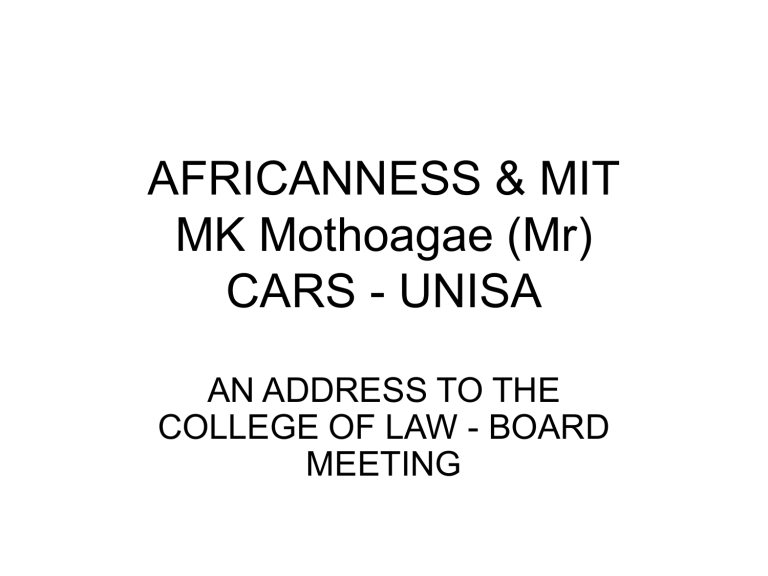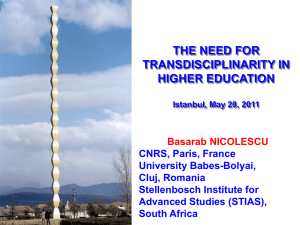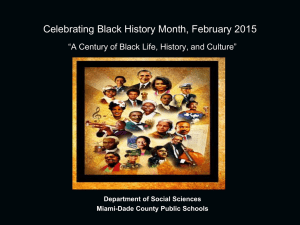AFRICANNESS & MIT MK Mothoagae (Mr) CARS

AFRICANNESS & MIT
MK Mothoagae (Mr)
CARS - UNISA
AN ADDRESS TO THE
COLLEGE OF LAW - BOARD
MEETING
Introduction
• The aim of this presentation is to give an expose of
CARS’ vision and mission within the African
Renaissance paradigm using Multi-, Inter- and Trans disciplinary approaches in advancing the understanding, interrogation, production, dissemination and use of knowledge.
• To this end the presentation will give a brief overview of some of the fundamental theoretical underpinnings of the
Inter and Trans disciplinary approaches; the contextualization and premise of CARS' academic offerings within the African Renaissance paradigm and its relevance within UNESCO’s & other Global
Educationbased Institutions’ declarations and recommendations.
CARS and the African Renaissance
Paradigm
• CARS’ academic offerings seek to create an understanding of the past, present & future of Africa.
• Pursue knowledge paradigms that are self-critical, in/outward looking & reflective
• Knowledge informed by the vision and spirit of the AR should inspire self-worth, dignity and respect among the Africans
(Gutto, 2004; 2005)
Paradigm Shift – T. Kuhn (1922 -
1996)
• CARS’s academic offerings are inspired by
Kuhn’s philosophy & vision of a PS;
• Thomas Kuhn’s book – “The Structure of the Scientific Revolutions” (1962);
• Kuhn vision & philosophy has revolutionized thinking about Science;
• Kuhn – used paradigm to refer to conceptual frameworks and/or worldviews of various scientific communities;
Paradigm Shift –T Kuhn(1922 -
1996)
• A paradigm of scientific revolution in Kuhn’s sense would be Copernican revolution;
• Paradigms are incommensurable;
• A change from one way of thinking to another.
• Paradigm shift is a revolution, a transformation, a metamorphosis.
• Kuhn’s image of a paradigm is useful in understanding one’s self and the changes taking place in all of life: scientific, social, legal, religious etc.
The African Renaissance Paradigm
• The African Renaissance Paradigm must advocate – African centered paradigms & epistemologies – as espoused by scholars
- Cheik Anta Diop,T Obenga,J Carruthers,
R Rashidi, M Asante, Grisso, Nabudere & others;
• The African Centered paradigm must be based on African Historiography and
African Worldview
The African Renaissance Paradigm
• Founded on the reconstruction of African history with emphasis on the Nile &
Ancient Egyptian- as pillars of restoration and self-identity;
• The Kemetic literature, the Timbu’ktu & other African IK manuscripts as resources to provide the foundation for an African Centered paradigm.
Inter & Trans-disciplinary
Approaches
• Multidisciplinarity – studying a research topic not in only one discipline, but in several simultaneously;
• Interdisciplinarity concerns the transfer of methods from one discipline to another. 3 degrees of application, epistemological, generation of new disciplines.
• Transdisplinary – between & across the different disciplines & beyond all disciplines. (Nicolescu et al.)
• Three Pillars of TD – Levels of Reality; Logic of the Included Middle & Complexity.
Inter-disciplinarity & Complexity –
Julie
T Klein (2004)
• Inter-disciplinarity – a result of the complex nature of knowledge
• Knowledge is depicted as a network or web with multiple nodes of connection, a dynamic system;
• Metaphor of unity, with values of universality & certainty are replaced by metaphors of plurality relationally in a complex world;
Inter-disciplinarity & Complexity – Julie
T Klein (2004)
• Images of boundary crossing and crossfertilization are superseding images of disciplinary depth and compartmentalization;
• Older values of isolated modes of work, control, mastery & expertise are being reformulated and replaced by dialogue, interaction and negotiation
;
Inter-disciplinarity & Complexity –
Julie T Klein (2004)
• Changes in the spatial & temporal structures of knowledge calls for changes in the traditional images of knowledge as a cognitive map with distinct borders and territories to images of knowledge as a kaleidoscope;
• Interdisciplinary activities interconnect in a shifting matrix with unpredictable synergistic relationship;
• Cultures in their ever-shifting interactions & complexities, need to be both researched and taught from interdisciplinary perspective.
From Inter to Transdisciplinarity -
Rethinking Problem-solving. JT
Klein
• Transdisciplinarity – a result of a need for a new approach to complex problems evident across fields of human interaction with natural systems
& fields of major technical development;
• A new discourse of trans-disciplinary problemsolving bridges the historical gap between calls for inter-disciplinarity and problem orientation, and a disciplinary, practical policy of support for natural sciences and technology;
From Inter to Transdisciplinarity -
Rethinking Problem-solving. JT
Klein
• UNESCO’s MOST program (Management of
Social Transformation) designed to bridge the gap - natural sciences and social sciences;
• Transdisciplinarity conference at Zurich regarded language as crucial, together with the challenges of achieving ‘communicative sustainability’ in the complex multilingual context of Africa;
• Researchers should also be aware ‘unofficial’ languages and discourses of stakeholders in such vital problem contexts such as health (HIV-
AIDS), ecology and agriculture;
Transdisciplinarity –The Three
Pillars: Basarab Nicolescu &
Others
• A new logic for a new reality
• Based on the principles of dynamic opposition and the law of the ‘included middle’
• Offers needed alternative to quasi-exclusive application of classical binary logic;
• The philosophic logic of Lupasco, extended by
Nicolescu through the ‘Principles of the Levels of
Reality’- is grounded in the major discoveries in quantum physics, biology, mathematics and the system science of the 21st century;
Aristotelian Logic of the “Excluded Middle
”
Rock
-A
Flower
Non-A
Gravity
Non-A
T-State
Aristotelian Logic of the “Excluded Middle”
•
• T-State= Containing the space is seen as empty
• T-State= non-connective
• T-State= non-participatory
• T-State= is the middle ground between the subject A and its reciprocal (the containing medium) “non A” is excluded from participation in the logical construct.
(Seb Henagulph 2000)
Stéphane Luspasco’s Logic of the “Included Middle”
Rock
-A
Flower
Non-A
Gravity
Non-A
T-State
T-State
T-State
Stéphane Luspasco’s Logic of the “Included
Middle”
• T-State = containing and connecting ensemble
• T-State= the logic of the included middle
• T-State= “Multi-reality participation of the containing space
• T-State= Interconnection, and implicit relativistic mediating space or included middle.
(Seb Henagulph 2000)
A-
Synopsis of Transition from
Mono to MIT
Mono- disciplinarity excluded middle
Non-A
A
Trans- disciplinarity
The Logic of the Included middle
T-State
Non-A
A New Vision &
Knowledge for a Complex World
As espoused in the following International
Declarations/Charters:
• The Locarno Congress – Which University for
Tomorrow?
• The Charter of Transdisciplinarity;
• World Declaration on Higher Education for the 21st
Century &
• Dakar Framework for Action
Declarations and Recommendations by
UNESCO and other Education-based
Institutions on their findings regarding:
• The problems confronting human kind in the 21st century;
• The solutions that are put forward to address these problems;
Declarations and Recommendations by
UNESCO and other Education-based
Institutions on their findings regarding:
• The role of education, especially Higher
Education on world issues;
• The kind of curricula, the type of learner/student emerging as a product of these institutions; etc.
A cursory survey on the four mentioned
UNESCO documents reflects unanimity on the following issues regarding Higher education and the role of the university:
• A loss of meaning and the universal hunger for meaning, the danger of the break between science & culture, University as bona fide
Institutes for the Research of Meaning; [
Locarno: 1, 7 & 8].
• Meeting the needs of education systems affected by conflict, natural calamities and instability – programmes designed to promote fully human person, respect for human rights & fundamental freedoms [Dakar: Str.5:58].
UNESCO documents reflects unanimity on the following issues regarding Higher education and the role of the university:
• Shaping a new vision of Higher Education advancing knowledge through research in science, arts and humanities –innovation, interdisciplinary & trans-disciplinary should be promoted and reinforced in programmes on social and cultural aims & needs
[WD HE 21st; Art 5].
• The keystone is the semantic and practical unification of the meanings that transverse and lay beyond different discipline, - the dignity of the human being is of both planetary and cosmic dimensions, [ Trans.
Charter, Art. 4 & 8].
CONCLUSION
The Question that we put forward to
Ourselfs, the Executive Dean, Board members, Colleagues can best be phrased in the words of Basarab
Nicolescu:
“ Which University for Tomorrow?”
Which University for Tomorrow?”?
Phrased in the context of the College of Law
& UNISA it could lend itself to the following critical questions:
• What kind of problems confront the
College of Law & UNISA’s students?
• To what extent are the programmes designed to address these problems?
Which University for Tomorrow?”?
Phrased in the context of the College of Law &
UNISA it could lend itself to the following critical questions:
• Is there a room for a paradigm shift in the true
Copernicus revolution in the College & the
Institution?
• Lastly, what kind of learner does the College &
UNISA envisages to bring about in dynamic world of the 21st Century
Bibliography
• Nicolescu, B.1996. Manifesto of Transdisciplinarity. Paris: Editions du Rocher.
http://www.Locarno
Congress, Switzerland. 1997.
http://www.Nicolescu
, Transdisciplinary Evolution of the University.
• Klein, J.T. 2004. Interdisciplinary and complexity: An evolving relationship. E:CO Vol. 6 , Nos. 1 -2, pp 2-10. Wayne State
University Press.
• Thomas Kuhn.
http://www.ee.scu.edu/eefac/healy/kuhn.html
• Giri, A.K. 2002. The calling of a creative transdisciplinarity. Futures,
No 34, pp. 103 -115. Elsevier Science Ltd. India.
• What is a Paradigm Shift?
http://www.taketheleap.com/define.html
I THANK YOU
KE A LEBOGA









